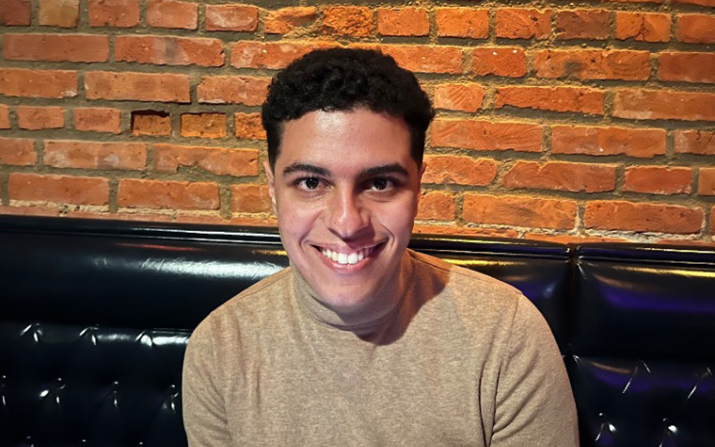Spartan Showcase: Luke Saad

Chemical engineering is all around us. It’s physical: we can see it, touch it and smell it. Take, for example, using car air fresheners or smelling your mother’s cooking.
Air fresheners take advantage of transport principles by using the mass transfer coefficient kin the air and agitating it, thereby decreasing the mass transfer resistance of the air. In this case, the vent in the car agitates the air, carrying the scent of the air freshener. This same principle is what allows us to smell the aromas of dinner on the stove, according to Luke Saad, a rising fourth-year student studying chemical engineering.
“Such small, yet commonplace examples use basic chemical engineering (ChemE) principles—and I do not think that I would be able to look at the world the same way without the education I’ve received at Case Western Reserve,” he explained.
Saad, an Allentown, Pennsylvania, native, is deeply engaged in research that extends these fundamental principles to advanced applications in tissue engineering. His work at the university focuses on artificially growing cartilage tissue in-vitro using specialized reactor systems that mimic physiological environments more closely.
Learn more about Saad’s research and his time at CWRU.
Answers have been lightly edited for clarity and length.
- Why did you choose your area of study?
I was unsure as to what I wanted to study. Because CWRU was known for its biomedical engineering research, I heavily considered majoring in the field, touting myself as a “BME hopeful.” However, as I looked at the bulletin for the major, I was let down at the prospect of having to study certain topics that did not interest me in fields pertaining to mechanical and electrical engineering. At the time, I was taking CHEM 111 with Dr. Meyer and was enjoying the class, specifically the topics relating to physical chemistry such as thermodynamics and kinetics. I decided to take the intro chemical engineering classes ECHE 151 and ECHE 260 the following fall. The rest is history!
2. Can you briefly describe your research topic?
Engineered tissue constructs grown in the lab typically lack the strength of native cartilage. There has been a push to try to bridge this gap by cultivating the cartilage tissue in a bioreactor that better mimics physiological environments. Our lab is tackling this issue by artificially growing cartilage tissue in-vitro using specialized reactor systems. The novel feature of the reactor is the mechanical actuator, which consists of a nylon ball that is mounted on a rod in an off centered manner. Rotating the rod provides a combined shear and compression force across a deformable membrane in the bioreactor growing the tissue. By using both shear and compression on engineered cartilage, it is possible to match the qualities of native tissue such that the former can function equally well in a joint when used as a replacement in cases of arthritis and debilitations.
3. How did you get involved with this work and what interests you most about it?
I have had a vested interest in tissue engineering due to some unfortunate events that have taken place in my family. My grandmother suffered from a terrible fall where she sustained serious injuries. As her treatment, she had steel intramedullary rods implanted, seriously limiting her mobility. These rods are severely inferior to our joints. This made me want to find a better alternative to this treatment. When researching potential labs to join, I happened to find Dr. Baskaran and the BioTransport Laboratory on the ChemE website. It seemed that the research goals of the lab and my interest aligned so I cold emailed Dr. Baskaran.
4. What do you hope will come from this research?
We hope to demonstrate that the bioreactor system with combined shear and compression produces more resilient cartilage when compared to tissue grown without any mechanical stimulus. Many tissue engineered products are made in research labs but few actually are able to be reproduced on a larger scale. Therefore, we also hope to demonstrate a path to the future manufacturability of cartilage tissue.
5. After undergrad, what are your aspirations?
To be honest, I am not really sure. As of now I am doing a summer/fall co-op at a pharmaceutical company. I am also possibly open to the prospect of applying to medical school. No matter where I go, I would like to be intellectually challenged and to be able to tackle problems that can help alleviate problems that everyday people face.
6. Are you involved on campus in any other ways?
Yes! I am also the president of CWRU MedWish, a biomedical engineering club whose goal is to repurpose donated medical devices. These devices are then sent to developing nations that lack a strong healthcare infrastructure. Our club has sent medical devices to countries like Nicagarua and Ethiopia!
7. Can you tell us a bit about your summer internship?
This summer/fall I am working as a process engineering co-op in a primary pilot plant at GlaxoSmithKline (GSK), a pharmaceutical company. The pilot plant serves two purposes: 1) To manufacture active pharmaceutical ingredients (API) for clinical trials and 2) to demonstrate the manufacturability of the API. My co-op involves drawing process flow diagrams and choosing the right equipment needed for the stages within a campaign. We are also responsible for introducing new equipment to the plant. I am excited to work at GSK and contribute to the goals of the pilot plant as a co-op.
